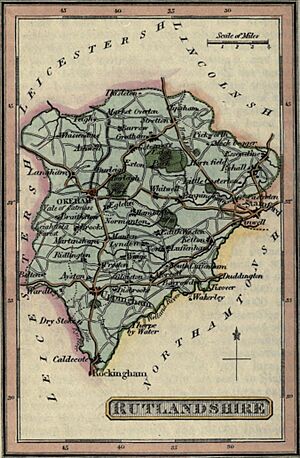History of Rutland facts for kids
The county of Rutland is a small but historic area in the East Midlands of England. It has a long and interesting past. Today, Rutland is a special type of local government area called a unitary authority. This means it manages most of its own local services. Before 1997, it was part of Leicestershire.
Rutland's Early Days
The first records of Rutland date back to 1086, in a very old book called the Domesday Book. At that time, the northern part of Rutland was actually considered part of Nottinghamshire. The southeastern part was known as Wicelsea and belonged to Northamptonshire.
Rutland was first called a separate county in 1159. However, even in the 1300s, people sometimes called it the 'Soke of Rutland'. A "soke" was an area where a lord had special legal powers.
In 1584, two famous schools were founded in Rutland: Uppingham School and Oakham School. These were some of England's earliest public schools. They were started by a man named Archdeacon Robert Johnson, who also built a hospital (or almshouse) for the poor. The original school buildings are still standing today.
The titles of Earl of Rutland and Duke of Rutland are very old and important. They belong to the Manners family. The Earl of Rutland became a Duke in 1703. The family's main home is Belvoir Castle, which is in Leicestershire.
Modern Rutland's Story
By the 1800s, Rutland was divided into smaller areas called "hundreds." These were named Alstoe, East, Martinsley, Oakham, and Wrandike.
In the late 1800s, new laws changed how local areas were governed. The Local Government Act 1888 gave Rutland its own county council. This meant Rutland could manage its own local affairs.
Later, in 1894, the Local Government Act 1894 further changed how areas were organized. Rutland was divided into several "rural districts" like Oakham, Uppingham, and Ketton. In 1911, Oakham became its own "urban district," meaning it had its own local council separate from the rural area around it.
During the Second World War, Rutland became home to three Royal Air Force (RAF) bases. These were Cottesmore, North Luffenham, and Woolfox Lodge. While Woolfox Lodge closed in 1966, the other two bases are still important for defence today. Cottesmore is now Kendrew Barracks for the British Army, and North Luffenham is St George's Barracks.
In 1974, a big change happened. The Local Government Act 1972 made Rutland part of the larger county of Leicestershire. This meant Rutland lost some of its independence. However, it was still a separate "non-metropolitan district" within Leicestershire.
But Rutland's story didn't end there! In 1994, a new review of local government suggested that Rutland should become a "unitary authority." This change happened on April 1, 1997. Rutland once again gained control over its own county services, like education and social services. It also got its own Lord Lieutenant, who is the King's representative in the county. Even though it's officially a "district council," it calls itself 'Rutland County Council' to show it manages county-wide services.
See also


